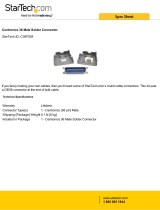
Rev. 3.02
- 2 -
SRP-350
■ Table of Contents
1. Precaution Segment....................................................................................................................................5
1-1 Safety Precautions...................................................................................................................................5
1-2 Servicing Precaution................................................................................................................................6
1-3 Precaution for Electrostatically Sensitive Devices (ESDs) ......................................................................7
1-4 Operational Precautions ..........................................................................................................................7
2. Installation and Operation ..........................................................................................................................8
2-1 Installation................................................................................................................................................8
2-1-1 AC Adapter Installation .....................................................................................................................8
2-1-2 Interface Cable Installation ...............................................................................................................8
2-1-3 Cash Drawer Cable Installation ........................................................................................................ 8
2-1-4 Paper Roll Installation .......................................................................................................................8
2-1-5 Wall Mount Installation...................................................................................................................... 9
2-2 Operation ...............................................................................................................................................11
2-2-1 Setting the DIP switches .................................................................................................................11
2-2-2 Setting the DIP switch (RS-232C Serial Interface) .........................................................................11
2-2-3 Setting the DIP switch (IEEE1284 Parallel, USB Interface) ...........................................................12
2-2-4 Hexadecimal Dumping....................................................................................................................13
2-2-5 The self Test Mode .........................................................................................................................13
3. Product Specifications..............................................................................................................................15
3-1 Appearance............................................................................................................................................15
3-1-1 Printer Dimensions (mm) ................................................................................................................15
3-1-2 AC Adapter Dimensions (mm) ........................................................................................................15
3-1-3 Feature Locations ...........................................................................................................................16
3-2 General Specifications...........................................................................................................................17
3-3 Thermal Printer Specifications............................................................................................................... 17
3-3-1 Printer Specification ........................................................................................................................17
3-3-2 Character Specification...................................................................................................................18
3-3-3 Paper Specification .........................................................................................................................18
3-3-4 Reliability and Environment Specification.......................................................................................18
3-3-5 Printable Area .................................................................................................................................18
3-3-6 TPH (Thermal Printer Head) Specification .....................................................................................19
3-3-7 Other Component Specification......................................................................................................19
3-4 SMPS Specifications .............................................................................................................................20
3-4-1 SMPS (Switching Mode Power Supply) Specification .................................................................... 20
3-4-2 SMPS Output Connector ................................................................................................................20
3-5 Interface Specifications..........................................................................................................................21
3-5-1 RS-232C Serial Interface ................................................................................................................21
3-5-2 RS-485 Serial Interface................................................................................................................... 23
3-5-3 IEEE1284 Parallel Interface............................................................................................................24
3-5-4 USB Interface..................................................................................................................................26
3-6 Cash Drawer Specifications...................................................................................................................27
3-6-1 Cash Drawer Cable......................................................................................................................... 27
3-6-2 Cable Connection ...........................................................................................................................27























